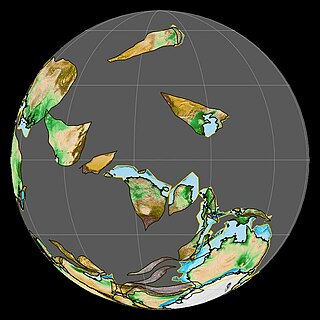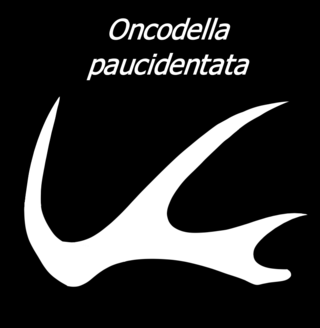The Bashkirian is in the International Commission on Stratigraphy geologic timescale the lowest stage or oldest age of the Pennsylvanian. The Bashkirian age lasted from 323.2 to 315.2 Ma, is preceded by the Serpukhovian and is followed by the Moscovian.

The Visean, Viséan or Visian is an age in the ICS geologic timescale or a stage in the stratigraphic column. It is the second stage of the Mississippian, the lower subsystem of the Carboniferous. The Visean lasted from 346.7 to 330.9 Ma. It follows the Tournaisian age/stage and is followed by the Serpukhovian age/stage.

The Serpukhovian is in the ICS geologic timescale the uppermost stage or youngest age of the Mississippian, the lower subsystem of the Carboniferous. The Serpukhovian age lasted from 330.9 Ma to 323.2 Ma. It is preceded by the Visean and is followed by the Bashkirian. The Serpukhovian correlates with the lower part of the Namurian Stage of European stratigraphy and the middle and upper parts of the Chesterian Stage of North American stratigraphy.
The Kasimovian is a geochronologic age or chronostratigraphic stage in the ICS geologic timescale. It is the third stage in the Pennsylvanian, lasting from 307 to 303.7 Ma. The Kasimovian Stage follows the Moscovian and is followed by the Gzhelian. The Kasimovian saw an extinction event which occurred around 305 mya, referred to as the Carboniferous Rainforest Collapse. It roughly corresponds to the Missourian in North American geochronology and the Stephanian in western European geochronology.

Hindeodus is an extinct genus of conodonts in the family Anchignathodontidae. The generic name Hindeodus is a tribute to George Jennings Hinde, a British geologist and paleontologist from the 1800s and early 1900s. The suffix -odus typically describes the animal's teeth, essentially making Hindeodus mean Hinde-teeth.
Paleontology or palaeontology is the study of prehistoric life forms on Earth through the examination of plant and animal fossils. This includes the study of body fossils, tracks (ichnites), burrows, cast-off parts, fossilised feces (coprolites), palynomorphs and chemical residues. Because humans have encountered fossils for millennia, paleontology has a long history both before and after becoming formalized as a science. This article records significant discoveries and events related to paleontology that occurred or were published in the year 1975.
Ellisonia is an extinct genus of conodonts in the family Ellisoniidae.
Spathognathodus is an extinct conodont genus in the family Spathognathodontidae. It is a non-Platform conodont, from the Pennsylvanian (Carboniferous).
Gnathodontidae is an extinct conodont family in the order Ozarkodinida. It consists of the extinct genus Icriodus.
Sweetognathus is an extinct genus of conodonts in the family Sweetognathidae that evolved at the beginning of the Permian period, in near-equatorial, shallow-water seas.
Clarkina is an extinct genus of conodonts. It is considered to be an offshore, outer shelf or basinal, deep-water taxon.
Gondolella is an extinct genus of conodonts in the family Gondolellidae.
Heinz Walter Kozur was a German paleontologist and stratigrapher.
Vjalovognathus is an extinct genus of conodonts.
Streptognathodus is an extinct genus of conodonts from the Late Carboniferous to Early Permian.
Conodonts are an extinct class of animals whose feeding apparatuses called teeth or elements are common microfossils found in strata dating from the Stage 10 of the Furongian, the fourth and final series of the Cambrian, to the Rhaetian stage of the Late Triassic. These elements can be used alternatively to or in correlation with other types of fossils in the subfield of the stratigraphy named biostratigraphy.
Neognathodus is an extinct genus of conodonts.
Declinognathodus is an extinct genus of platform conodonts.

Oncodella is an extinct genus of Late Triassic conodont. The genus was given the type species Oncodella idiodentica by Mosher (1968), on the basis of fossils from the Late Triassic of Austria. However, Mosher (1969) later revised the species name to Oncodella paucidentata, since identical fossils from the same area were previously given the name Hindeodella paucidentata by Mostler (1967).

Amphissites is an extinct genus of ostracod belonging to the suborder Beyrichicopina and family Amphissitinae. Species belonging to the genus lived from the Devonian to the Permian in Europe, North America, Australia, and east Asia. The genus were likely deposit-feeders, and may have survived briefly into the Triassic.




